
International Research Journal of Engineering and Technology (IRJET) e-ISSN:2395-0056
Volume: 11 Issue: 10 | Oct 2024 www.irjet.net p-ISSN:2395-0072


International Research Journal of Engineering and Technology (IRJET) e-ISSN:2395-0056
Volume: 11 Issue: 10 | Oct 2024 www.irjet.net p-ISSN:2395-0072
Ramratan1, D.S. Mandloe2 , Dr. Himanshu Agarwal3
1Research Scholar, M. Tech. (Thermal Engg.)
2Assistant Professor, Department of Mechanical Engineering,
3Professor and Head, Department of Mechanical Engineering
Jhada Sirha Government Engineering College Jagdalpur, Bastar Chhattisgarh India
Abstract -This analysis discusses the similarities and irregularities found in the outcomes, focusing on a broader range of factors that influence the Solar Air Heater (SAH) efficiency. Researchers have conducted numerous experiments to examine how the operation and shape of the solar air heater impact heat exchange and the movement of fluids. The types of rib roughness observed include transverse, inclined, arc-shaped, and V-shaped. The focus of this research is on understanding the physics behind the heat transfer and fluid dynamics around these rib surfaces. The analysis also covers the latest developments in the study of repeated rib roughness in SAHs, highlighting their historical context. Additionally, the application of artificial roughness on the air flow side of the absorber plate in a solar air heater is identified as a key method to improve its thermal efficiency.
Key Words: Solar air heater, Repeated-rib roughness, Heat transfer enhancement.
Renewable assets are copious in nature and usable in a wide extend. Sun oriented vitality is accessible in bounty and may be a promising substitute. Sun powered vitality could be a valuable and promising renewable energy resource with applications in a variety of devices and shapes. Although specialized solar energy use potential has previously been established, these sources remain unprofitable from a business standpoint. To plan for the creation of financially valuable solar energy, one of the critical necessities is it productive collection By utilizing sun oriented collector it can be utilized specifically in a few warm applications The execution of SAH can be measured in terms of heat productivity (ƞ), successful productivity(ƞeff),exergyeffectiveness(ƞexg)andthermalhydraulicexecutionparameter(THPP). Withinthecase of constrained convection based SAH, the outlet discuss temperature(To)isouralluringyieldparameternotatall like characteristic convection based SAH where the mass streamrateisadditionallycritical. Mustbeconsideredfor itsexecutionassessment.ThestrategieslikeMulticoating, reflectors, cleaning of safeguard plate, etc. don't alter the regionorlengthofthewindstreamway;consequently,the weight misfortune remains the same. The execution assessmentofsuchprocedurescanbecarriedoututilizing, which is the work of as it were To. Whereas, in multi-
passing, alter in cross-section of SAH conduit, balances, confuses, etc. ƞeff is considered for execution evaluation, which is the work of both To and pressure misfortune. THPP con siders contact calculate and warm exchange coefficient with regard to the baseline/reference case (smooth channel); thus, it is prescribed for the ribroughness.
The average yearly energy use per person in the USA stands at 8000 kWh, in stark contrast to India's usage of just 400 kWh, illustrating the vastness of the subject of Renewable or Non-conventional Energy Resources. These resources, which include energy from the Sun, Wind, and Ocean, are crucial assets for a nation's economic and environmental strategy, thanks to their environmental benefits and role in sustainable development. Over the past few years, these resources have emerged as a key component of energy production. The use of renewable energy is increasingly becoming a key consideration for countries worldwide, as it is clean, abundant, and a significant source of power. There are various renewable energy technologies that are now widely used and recognized as a major industry by countries globally. The way energy is used in developing countries like India shows a trend that favors urban areas, leaving rural regions,likethoseinIndia,withasignificantenergygapin availability.Energycanbecategorizedaseitherrenewable or non-renewable. Non-renewable sources such as coal, oil, gas, and nuclear fuels have taken millions of years to form and are expected to run out within decades or centuries. On the other hand, renewable energy sources likesolar,wind,andtidalenergyarenaturallyreplenished, ensuring their supply does not diminish with use. At present,the majority ofthe world's energy needsare met by fossil fuels. Recent advancements in solar air heater technology, such as the development of integrated and hybrid systems, have improved their efficiency and functionality. It's important to highlight these advancements to understand the current trends and futureprospectsofsolarairheatingtechnology.

International Research Journal of Engineering and Technology (IRJET) e-ISSN:2395-0056
Volume: 11 Issue: 10 | Oct 2024 www.irjet.net p-ISSN:2395-0072
Nomenclature
H- Depthofduct,mm
I- Intensity of solar radiation, W/m2
L - Length of test section of ductorlongwaylengthofmesh, mm
P- Pitch,mm
q
u- Usefulheatflux,W/m2
Q
u- Usefulheatgain,W
T
am - Meanairtemperature,K
Ti - Fluidinlettemperature,K
Tf - Fluid outlet temperature,
K
T
pm - Meanplatetemperature,K
W- Widthofduct,mm
w- Widthofrib,mm
∆P- Pressuredrop,Pa
SAHs-Solarairheaters
e/D- Relativeroughnessheight
e/H - Ribtochannelheightratio
Fo - Collectorefficiencyfactor
Fr - Collector heat-removal factor
Fr - Friction factor for rough surface
g/e- Relativegapwidth
g/p- Relativegrooveposition
Gd/Lv-Relativegapdistance
L/e - Relative log way length of mesh
Nu- Nusseltnumber
Nur - Nusselt number for rough channel
Nus - Nusselt number for smoothchannel
P/e- Relativeroughnesspitch
Pr- Prandtlnumber
St- Stantonnumber
W/H- Ductaspectratio
W/w- Relativeroughnesswidth
Greek symbols
Φ - Wedge angle/chamfer angle,degree
α- Angleof attack,deg.
δ- Transitionsub-layerthickness,mm
ε - Dissipationrate,m2/s3
ηth - Thermalefficiency
µ- Dynamicviscosity,Ns/m2
ρ- Densityofair,kg/m3
ω - Specific dissipation rate,1/s
Table1.
2.1
In this methodological framework, a prototype of a solar air heater is constructed, and empirical investigationsareconductedonthismodel.Theprototype may either possess identical dimensions to those of the actualsolarairheaterorberepresentedasascaledmodel (either reduced in size or enlarged). The operating parameters are employed for the assessment of the thermal performance of a solar air heater. During the experimental process, the researcher must meticulously consider factors such as the duration required for the investigation, the financial implications associated with the prototype's fabrication, the accessibility of experimental facilities, and the precision of measurement instruments. Human error, measurement inaccuracies, and atmospheric conditions encountered during the experimentation can significantly influence the reliability of the data obtained from the experimental configuration Numerous researchers have explored a diverse array of operational and geometrical parameters and endeavored
to ascertain precise estimations of the heat transfer coefficient and friction factor for the roughness geometry underexamination
Nikuradse (1933)conductedaninvestigationintothe frictionallossphenomena withinsand-roughenedcircular pipesthatwereunheated,acrossanextensivespectrumof Reynolds number (Re) values, in contrast to prior investigations focused on rough surfaces. Findings: delineated three distinct flow regions predicated on the correlation between the friction factor (f) and the roughness Reynolds number (e+); identified hydrodynamicallysmoothflow(070);introducedamodifiedlaw of the wall to characterize the velocity profile: u+ = 2.5ln(y/e)+R(e+)
Cope (1937) Conducted an investigation into the influenceofductcross-sectional shapes namelycircular, square, and rectangular on thermal regulation within a smooth pipe (Subsequently, in 1941, the same researcher examined heat transfer phenomena within rough pipes (Cope, 1941)) for Reynolds numbers extending up to 50,000. Discoveries shown that the hydraulic diameter (Dh) is pertinent to non-circular channels; the heat exchange coefficient (h) and friction calculate (f) don't essentially show synchronous increments; besides, the grinding calculate does not shift consistently beneath conditions of constant heat flux and constant wall temperature.
Brouillet and Meyers (1947) Performed experimental analyses on the effects of transverse and triangular internalgrooveswithinaturbulentflowenvironment.The resultsillustratedthatthevaluesofhandfinroughpipes are, individually, 2 and 1.5 times more prominent than thosewatchedinsmoothpipes.
Kolar (1965) Webb et al. (1971, 1972,) Testedwith60° triangular string with discuss and water as a working liquid for variable breadth to unpleasantness proportion, Re and Pr values. Comes about: The esteem of gets to be steady, and diminishes at higher Re; cost-effectiveness is anbasicparameterwithintheplanofaheatexchanger.
Webb et al. (1971, 1972), (Dipprey and Sabersky, 1963), (Nikuradse1933) Forvariablerelative roughness tallness (e/D) and relative unpleasantness pitch (P/e) values of the rehashed transverse ribs, covering a wide run of Pr values. Comes about: An expression for broadly utilizedparameterthermal-hydraulicexecutionparameter (THPP)wascreated.Asinglerelationshipcannotworkfor all roughness geometries as proposed within the prior studies; because, variety in rib-geometry causes impressivechangeswithinthevaluesofhandf.

International Research Journal of Engineering and Technology (IRJET) e-ISSN:2395-0056
Volume: 11 Issue: 10 | Oct 2024 www.irjet.net p-ISSN:2395-0072
RoughnessGeometry BoundaryconditionandResults
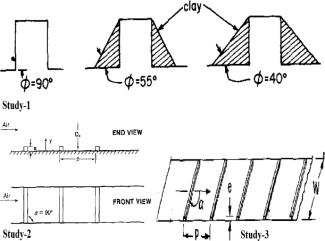

Han, 1984; Han and Park, 1988) Transverse-cornered, transverse and inclined ribs; L×W×H L 1275 mm, W 51–102 mm, H 51–225 mm, W/H 1–4, P/e 10–20, e/D 0.021–0.078, 30–90°,L/D10–20,Re8000–80,000, I 950–2500 W/m2 Resulted in optimal heat transfer for square channels attributable to the pronouncedsecondaryflow.
Webb and Eckert (1972) elucidated that the transverse wireribs,alongwiththecredibilityofthe correlation established in the antecedent investigation, were corroboratedbytheextantscholarly literature.

HanandZhang(1992)investigated the characteristics of V-shaped, crossed, and inclined ribs with dimensions of L×W×H 1016×50.8 ×50.8, P/e 10, e/D 0.0625, L/D 20, angles ranging from 45° to 90°, and Reynolds numbers between 15,000 and90,000.
Thesuniscapableforahugenumberofotherrenewable energies (such as wind and hydropower) as well as renewable vitality carriers (such as strong or fluid biofuels). The sun is one of the foremost capable normal and green sources of vitality, giving a ample supply of renewable and clean vitality. Sun oriented vitality can offer assistance to diminish dependence on fossil fills and it has the potential to supply a economical source of control for a long time to come. Sun powered warm vitality can be saddled through a number of diverse strategies, counting sun based warm collectors and sun orientedwarmcapacity,etc
Reynolds number decides the nature of the stream. SAH could be a warm exchanger in which warm exchange happensthroughconstrainedconvection.Renoldsnumber (Re) plays vital part in choosing its execution. But never works alone; instep, its impact changes with variety in other parameters like e/D, P/e, insolation I, etc. In lower Re implies laminar stream that's incapable to exasperate the sublayer thus lower warm exchange and weight misfortunehappens.ButcontactishigherformooRedue tothethickeningofthesublayer.

Momin etal.and Rajendra Karwa (1998) examined V-shaped continuous ribs as a textural element on the absorber plate of a solar air heating duct, analyzing a roughness height (e/D) of 0.2-0.34, P/e 10, and Reynolds numbers spanningfrom2500to18000.
Table 2. Heat transfer and frictional losses for fluid flow
Han et al. (1978) Examined cornered rib angle (ϕ) and P/ethe impact in angle of attack(α),on parallel plates. Comes about: created relationships for h and f based on divider similitude and heat-momentum relationship. Corner point did not have a critical impact, but P/e and havedistinctlyimpactontheexecutionofrib.
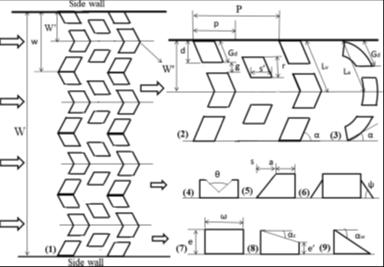
Fig. 1. All possible parameters investigated in a repeated-rib roughness.

11 Issue: 10 | Oct 2024 www.irjet.net
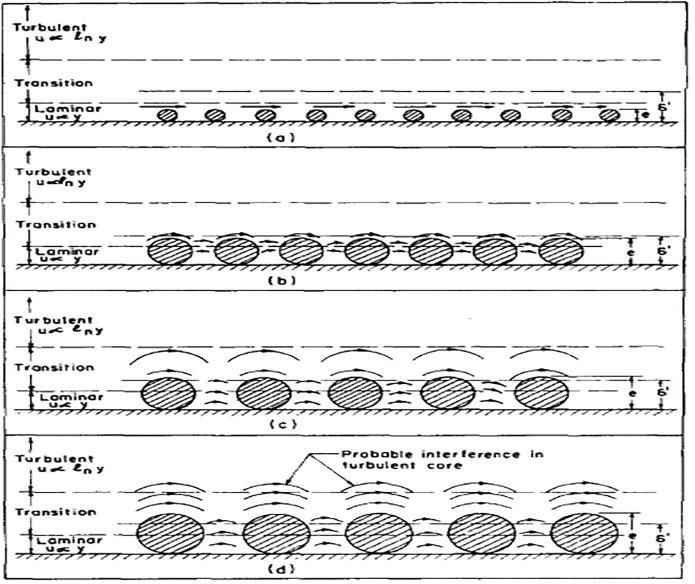
Fig.2 Prasad and Saini, 1991 Effect of e/D, P/e and rib cross section on reattachment Differentroughness heightabovesurface.
3.THERMAL HYDRAULIC PERFORMANCE OF SAH USING VARIOUS METHODS:
This concept covers the strategies utilized to survey the execution of sun powered discuss radiators, counting test setups and recreation procedures. Assessing execution is basic for comparing distinctive frameworks and making stridesplanproficiency.
Henry Buelow, 1958; Rapture, 1959; LOF et al., Buelow, 1962; Near, 1963; 1964; Chiou et al.1965; Gupta and Garg, 1967; Suri and Saini, 1969; Charters, 1971; Malik, 1973; Diaz and Suryanarayana, 1981; Bhargava et al., 1982; Garg et al., 1985). Thermal effectiveness by multi-passing, multi-glazing, layered surface, wire-mesh, changing conduit shape-size-aspect proportion,permeablemedia,paint-materials,etc
Man Singh Azad 2024- Artificial roughness, utilizing askew chamfered cuboids, altogether upgrades sun powered discuss radiator execution, accomplishing 2.48 times change in warm proficiency compared to smooth surfacesbeneathcomparativeconditions.
Avinash K. Hegde, Raghuvir Pai, K. Vasudeva Karanth (2024) V rib unpleasantness in sun oriented discuss radiators improves thermohydraulic effectiveness, accomplishing upto76.63% effectiveness at particular conditions, compared to smooth plans Relationships for contact calculate and Nusselt number MATLAB code for thermohydraulicandexergyeffectivenessinvestigation.
SAHconfiguration

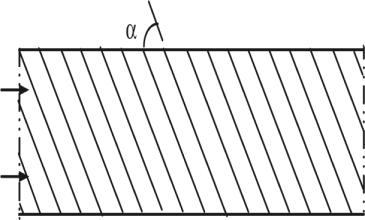
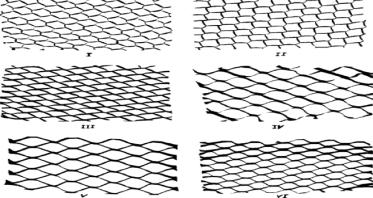
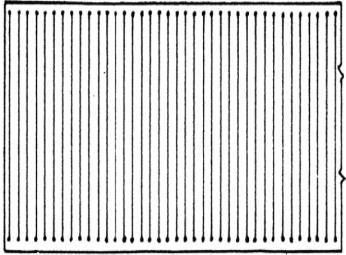
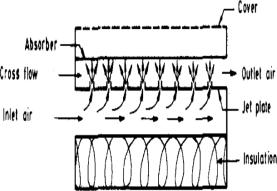
Boundaryconditionand results
Henry buelow, (1956) The shorter rectangular conduit of max conceivable contract entry with discuss streaming within the transitional flow administration had the finest execution
Gupta et al. (1997) Slanted rib with crevice Ideal Re was within the run of 13,00019,000asper thee/D esteem andtheroughnesswasviable forthelowere/Dvalues
Chiou et al. (1965) The porous media retains daylight in profundity of SAH-duct, decreases best misfortunes and have heat transfer,volumeproportion.
B. N. Prasad et al. (1988, 1991,2000&2013) TransversecircularCSribs,
Gupta et al. 1993
Transverse thin wire-Ribs, L×W×H 1640×150×H, H 13–22 mm, W/H 6.8–11.5, P/e 10,e/D0.018–0.052,e+ 5–70
Choudhury & Garg 1991
L×W×H (no ASHRAE standard), L 1000–8000 mm, H 50–100 mm, Re 300–30,000, G 50–250 kg/hm2, dia of jet D 4–12 mm, No. of jet 0-4D, inter-spacing of jet X/D 6–12, m jet 0–50 kg/hm2, Vjet 1–3 m/s I 900 W/m2,Vw 1.5m/sandTi 300 K
Table 3. Improve performance of a SAH
J.L. Bhagoria a, J.S. Saini b, S.C. Solanki The effect of parameters on the heat transfer coefficient and friction factorarecomparedwith theresultofsmoothductunder similar flow conditions. Statistical correlations for the Nusseltnumberandfrictionfactorhavebeendevelopedin terms of geometrical parameters of the roughness elementsandtheflowReynoldsnumber

Volume: 11 Issue: 10 | Oct 2024 www.irjet.net
Sahu and Bhagoria In their study transverse ribs as unpleasantness expressed that at higher pitch esteem reattachment focuses gotten to be less and at moo pitch esteem the number of reattachment point is unimportant due to which rate of warm exchange diminishes. The geometrical harshness and stream parameters included werepitch(p)of10-30mm,ribcomponenttallness(e)of 1.5 mm, conduit angle proportion (W/H) of 8 and Re of 3000-12,000. They detailed that fake harshness increases the warm exchange coefficient 1.25 to 1.4 times smooth surface. They moreover detailed most extreme expansion in Nusselt number (Nu) and warm effectiveness happens atpitchof20mm.
Sharma and Kalamkar Explored exploratory and numericalexaminationofSAHconduit withfoursetupsof different lean nonstop transverse and truncated ribs as delineated in Fig. 1.11. The geometrical unpleasantness parametersincludede/Dh10as0.055,αas90○,P/eas10, blockage proportion (e/H) of 0.1. They found that most extreme and least thermo-hydraulic execution parameter (THPP) in case 3 and case 2 separately comparing to extendofparametersconsidered.
V-shape ribs are of the shape of the English letter set V, and its summit meets at the center of the channel. It has two slanted ribs assembly at midspan of the conduit, and Fig. 9 appears different variety in V-shape: (1,2) nonstop ribs V-up and V-down, (3,4) with single and numerous gaps, (5,6) amazed rib on single and different crevices, (7,8,9)multi-Vwithholeandamazedribs.
Roughness Geometry
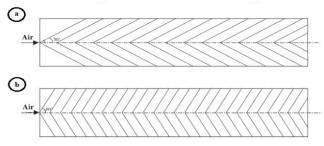
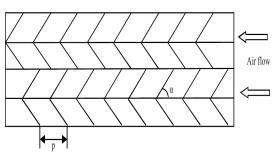

Boundary condition and result
Ebrahim Momin et al., (2002)
L×W×H 1200×200×20, P/e 10, e/D, 0.02–0.034, 30–90°, Re 2500–18,000,I1000W/m2 andTi 300K
V-up–down-continuous & transverse & inclined ribs, R. Karwa, 2003 (Karwa, 2003):All investigatedribsareinthefollowing increasingorderofenhancement
V-down ribs with multi gaps, Maithani & Saini (2016) L×W×H 1100×300×25,P/e6–12,e/D,0.043, g/e1–5,Ng 1–5,d/W′NA,30–75°, Re4000–18,000,I1000W/m2
Roughness Geometry
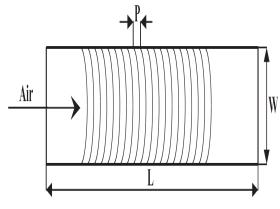
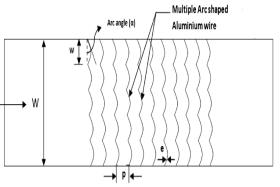
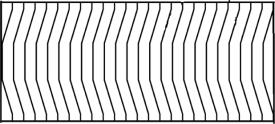
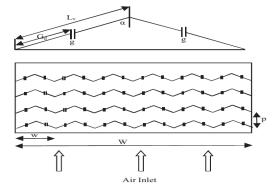
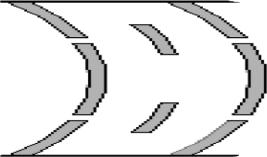

Boundary condition and result
Continuous arc-down-shape ribs Sahu et al. 2016 & 2017 (Sahuand Prasad,2017) L×W×H 1500×1000×25,P/e10,e/D0.023–0.0422,30–60°,Re2000–39,000(too highforSAH),Vw 1m/sI500–1000 W/m2 andTi 300K,T/IK/m2W 0.0025–0.010
Continuous S-shape ribs, Khushmeet et al. 2017 (Kumar et al., 2017): L×W×H1000×300× 25, P/e4–16,e/D,0.022–0.054,W/w1–4,30–75°,Re2400–20,000,I1200 W/m2
Continuous arc-shape ribs Sharad et al. 2009 (Kumar and Saini, 2009) L×W×H1500×300×25,P/e 10,e/D0.0299–0.0426,30–60°,Re 6000–18,000,I1000W/m2,Ti NA, RNGgivesmaxTHPP
Multi V-shape rib with gap, Anil et al. 2012 & 2013 (Kumar et al., 2012; Kumar et al., 2013) L×W×H 1000×300×25
Continuous-arc-shape ribs with gap Gill et al. 2017
Transverse ribs of different crosssection, Yadav & Bhagoria (2014) RNG,P/e7.14–35.71,e/D0.021–0.042,Re3800–18,000,I1000 W/m2 andTi 300K
Table 4. Enhance thermal–hydraulic performance
Relative rib width, W/w:Itrepresentsthenumberofribgeometryspan-wise, higher thevalue of W/wmoreisthe number of rib-geometry, but it decreases the measure of therib.StreamstrikesatthecenteroftheV-shapeorarcshaperibs,andauxiliaryflowinducesinboth thelimbsof rib-geometry.Thenumberofribsincreasesspanwisewith increase in W/w, with its reduced length which increments the number of secondary flows within the span-wise direction that creates a part of turbulence and mixingofgenerallydifferenttemperatureflow.

International Research Journal of Engineering and Technology (IRJET) e-ISSN:2395-0056
Volume: 11 Issue: 10 | Oct 2024 www.irjet.net p-ISSN:2395-0072
5. Summary input-output parameters of different types of rib:
BasedontheresearchconsidersThissegmentisexamined inarrangedframe,whereTables2-4summaryofdifferent modern studies (last two decades) for trans verseinclined, V-shape and arc-shape ribs. The left column shows the geometry of the rib, and the correct column gives the brief details of respective boundary conditions and results. These studies are arranged in chronological arrange;inanycase,afewcommonstudiesbythesame.
6. Conclusions:
The present review is provided an overview of recent trends in solar air heater research with rib-roughness initiated enlargement. An exertion is put to draw considerationtothechronicledfoundationtohighlightthe evolution within the plan conjointly the part of pioneers (regularly ineffectively cited) within the advancement of SAH innovation. The parameters like shape, estimate of the channel, insolation, surrounding conditions, fabric of developments altogether influence the execution of SAH. Subsequently, these are examined in brief. Final two decades of investigate on the abuse of repeated-ribroughness to irritate the thick sublayer to upgrade warm exchange is completely checked on, which recommends thetakingaftervitalfocuses:
Energy and exergy assessments for different V ribs in SAH. Ideal plan parameters utilized for particularribexamination.
Nusselt number and contact calculate altogether higherthanlevelplate.Warmimprovementfigure calculatedas1.56forroughSAH.
Greatest heat exchange improvement found at 45○.GreatestThermohydraulicExecutionat30○
V-Shape unpleasantness upgrades warm exchangeexecution.
3D cylinder roughness upgrades SAH proficiency byprogressingheatexchange.Grindinglossesare decreasedwithpresentedroughnesselements.
Most of the discoveries collectively concur on the comparativeidealvaluesoftherib-geometry:e/D, P/e, , and which has too been inquired about in gasturbineblade-domainofinquireaboutinpast. Be that as it may, the incorporation of holes and stunnedribsmayaltertheiridealesteem.
References:
1. B.N,PRASADandJ.S.SAINI(1988).Effectofe/D, P/eandribcrosssectiononreattachment
2. PrasadandSaini,(1991)Effectofe/D,P/eandrib cross section on reattachment Different roughnessheightabovesurface
3. Fahad A. Al-Sulaiman (2014) The study demonstratesthattheHDHconfigurationwiththe air heater placed between the humidifier and the dehumidifier has a better performance and a higherproductivity
4. Hanetal.(1978)investigatedtheeffectofangleof attack (α), cornered rib angle (ϕ) and P/e on parallelplates.
5. Avinash K. Hegde, Raghuvir Pai, K. Vasudeva Karanth 2024: Energy and exergy evaluations for various V ribs in SAH. Optimum design parametersusedforspecificribanalysis.
6. Man Singh Azad (2024) km Enhanced thermal performance of solar air heaters. Artificial roughnessusingdiagonallychamferedcuboidsfor efficiencyimprovement.
7. Hassan A.H. Alzahrani, G.T. Danappa,(2023) Enhanced heat transfer and reduced friction losses in solar air heaters. Introduction of 3D cylinder roughness elements for improved efficiency.
8. Prasad, R.K., (1993) Thermal performance CharacteristicsofUnidirectionalFlowPorousBed SolarEnergyCollectorsforHeatingAir.
9. Mustafa M. M. Alaskari, Arwa Mahmood Kadhim (2022) Increased total thermal efficiency of Solar Air Heater (SAH). Prediction of SAH efficiency usingnumericalmodel.
10. P. D. Raturi, Hemlata Deolal, Sanjeev Kimothi (2022) Optimize hot air use with Return Flow Solar Air Heater. Analyze thermal and thermohydraulic efficiency with baffle arrangements.
11. Piyush Kumar Jain, Atul Lanjewar (2021) Augmented thermal performance of solar air heater. Evaluated V-rib roughness with staggered elementgeometry.
12. Voisin, Claire (2023): Analyzed thermal performance of roughed solar air heater using CFD
13. Karmveer, N. Kumar Gupta, Md Irfanul Haque Siddiqui (2022) Roughness improves solar air heaterperformance.